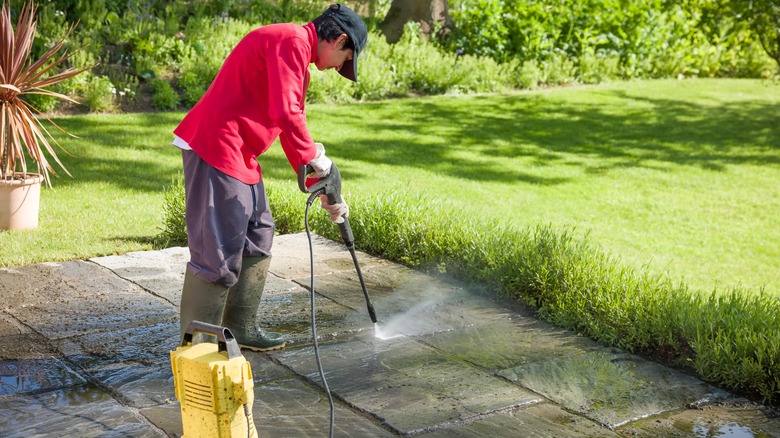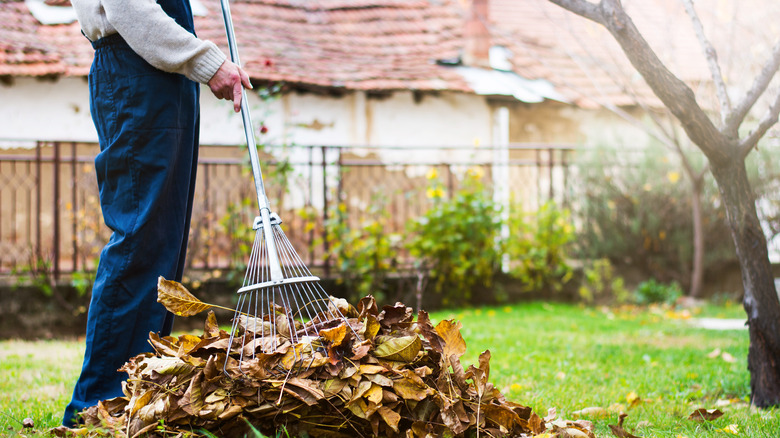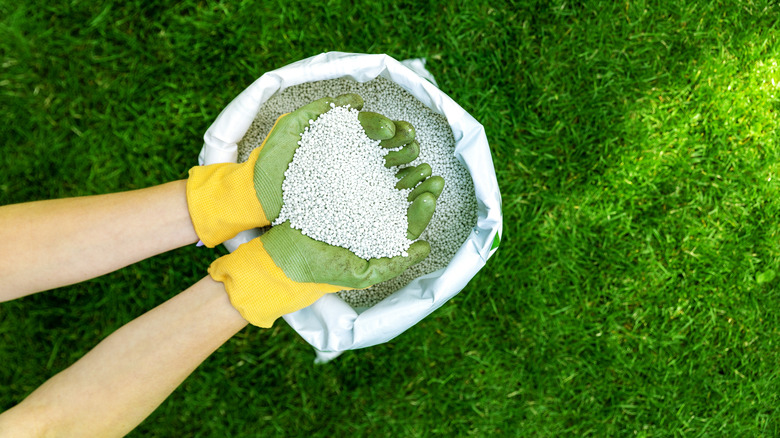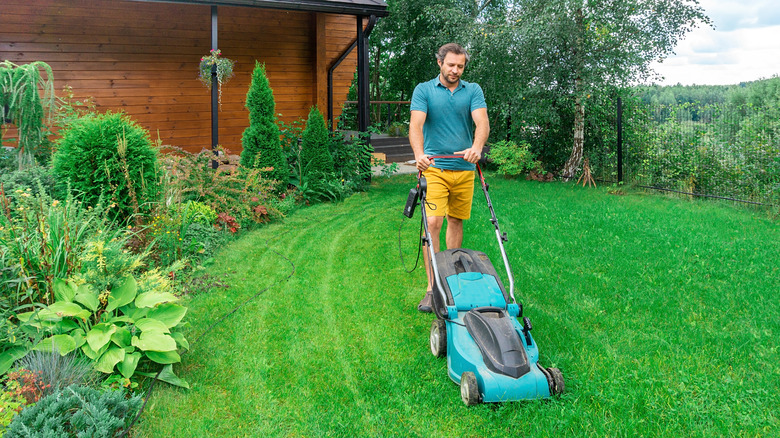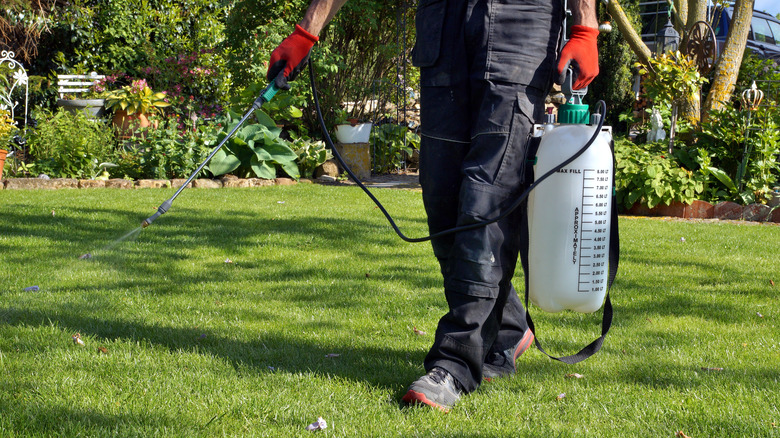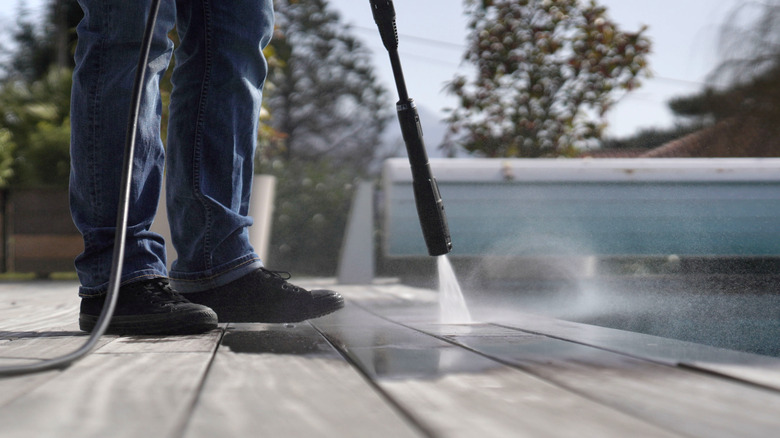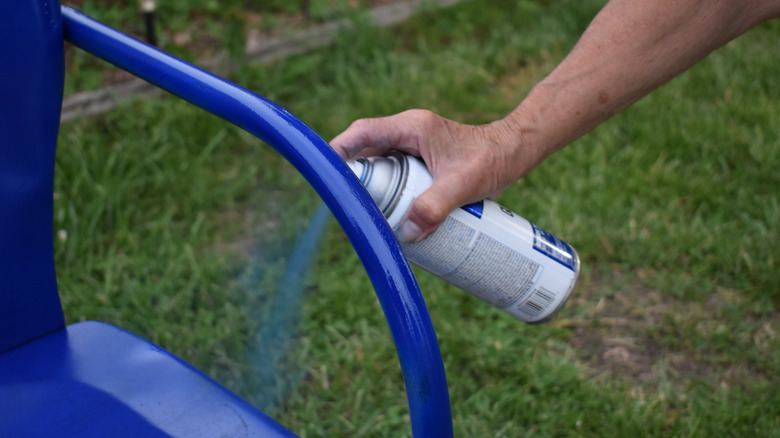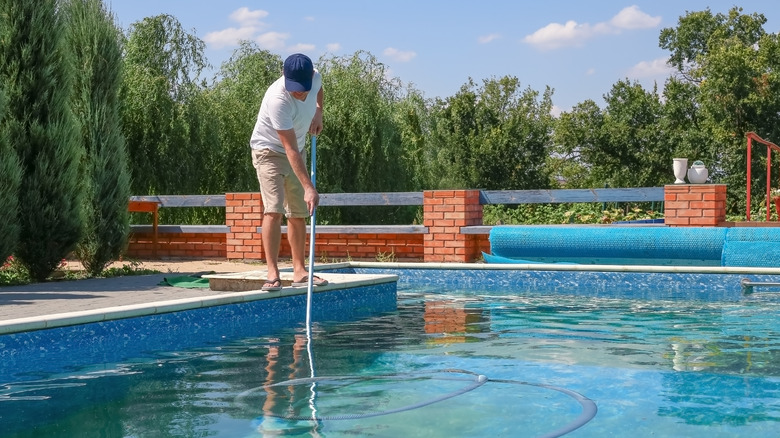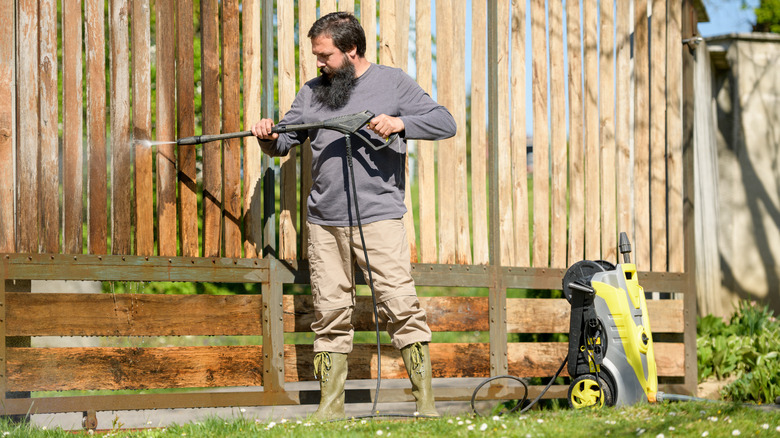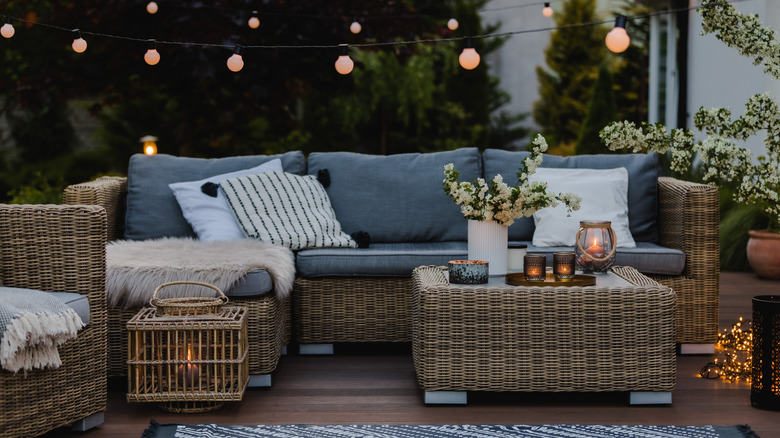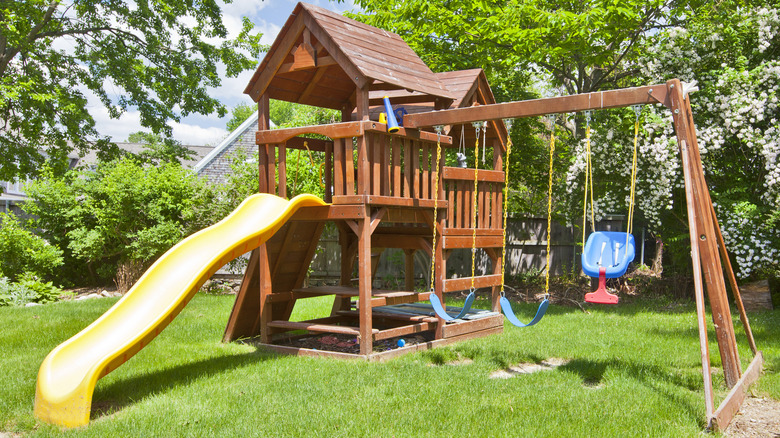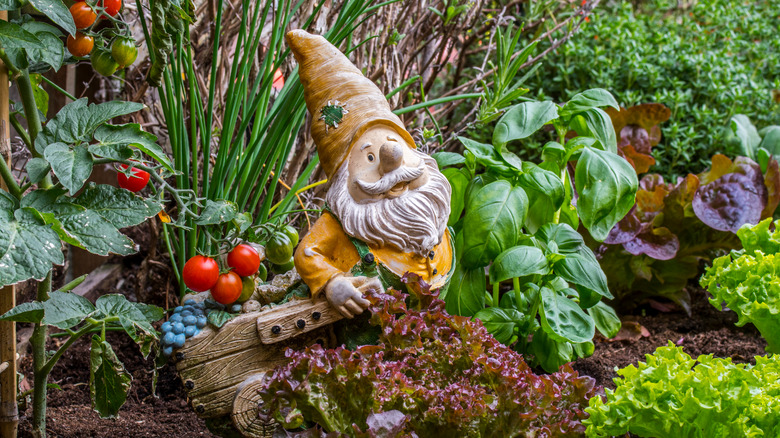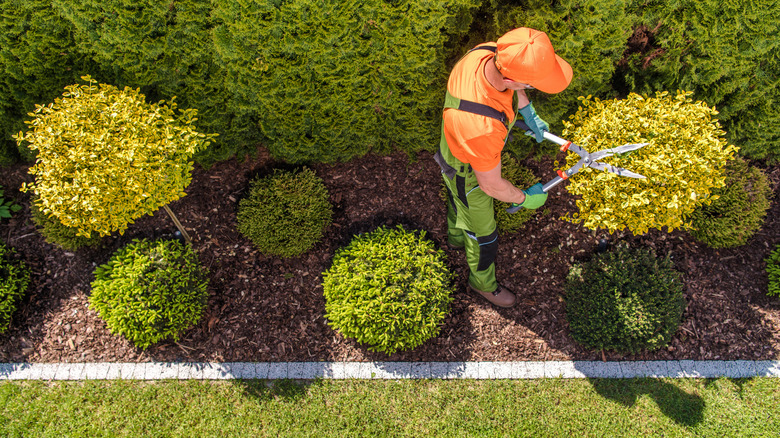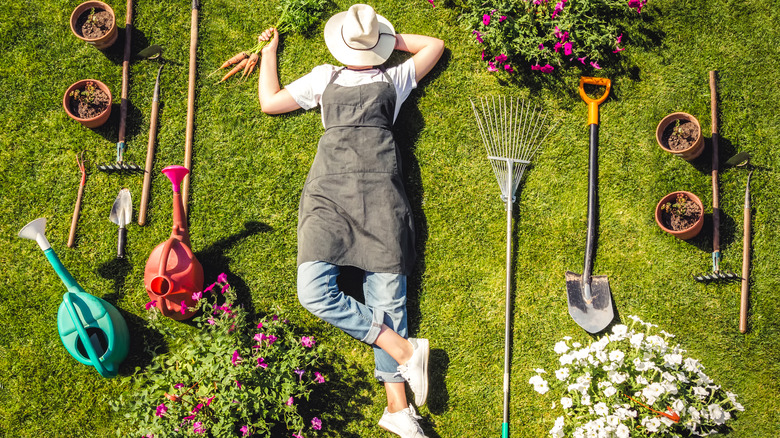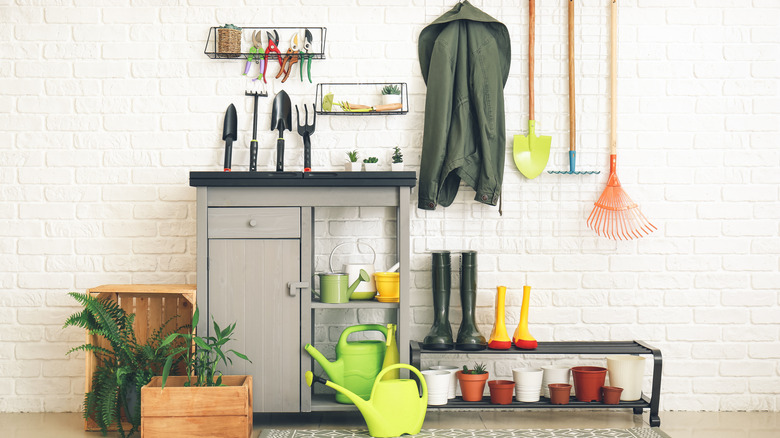How To Clean A Backyard
Springtime is here, which means warmer weather, as well as spring cleaning. While families may neglect cleaning the backyard during the colder months, now is the time to get started on this major cleaning project. Cleaning a backyard doesn't have to be stressful. According Simply Maid, tackling your backyard cleanup project is best done in steps to keep things as easy and organized as possible.
When it comes to major clean up projects, throw away or donate anything unneeded. Reduce the clutter by putting away any yard tools or gardening tools to clear the yard. If there's too much rubbish, a trash removal company could be called for pickup. Mowing the lawn and getting rid of stubborn weeds is also another important step. Adding durable tables with cushioned lawn chairs are ways to provide stability and comfort for those sunny get-togethers. To add a special touch to the backyard, consider installing outdoor lights. The possibilities are limitless, but here are specific recommendations for cleaning a backyard.
Tidy up by raking leaves
Raking leaves isn't just a chore to do during the fall. When leaves fall from trees, thick layers of leaves could cover the grass and prevent it from growing due to lack of direct sunlight, according to The Spruce. Raking leaves is important for overall lawn health as well, since sometimes, leaves may carry and spread diseases from trees. A clear lawn without piles of leaves will look well cared for and presentable. Rakes are inexpensive and can be found at local home and gardening stores.
What to do with raked leaves? Family Handyman suggested buying or making a compost bin to break down the leaves into mulch, which can then be used to improve the soil in your garden beds. If finding a compost bin isn't possible, check out local compost facilities within town. These are the best ways to dispose of leaves, and are much more environmentally-friendly than other methods, such as burning them or throwing them in the trash.
Filling in the bare spots
When it comes to backyard wear and tear, a fairly common issue is bare spots in lawns. This occurs when there's heavy foot traffic from children and pets. Bare spots in grass also occur due to pests and mites that like to attack and eat grass. How can this be resolved? The Spruce explains that, though it may take two to three weeks for the grass to grow back and to begin mowing, adding grass seed to bare spots or using a roll of grass sod could be acceptable ways to patch things up. Make sure the soil is fertile enough for growing grass, and be sure to water the area regularly. Keep an eye out for sprouts to make sure there's progress in new growth.
After filling in bare spots, buy weed control products to keep weeds from taking over your lawn. Scott's advises carefully reading labels and following the directions for applying any product. Keep these products out of the reach of children. Though they hatch during the summertime, grubs make their appearance around spring and destroy lawns. If these pests have been a problem for your lawn in the pest, you may want to apply a pesticide to combat them.
Mow the lawn
Mowing should be a top priority. Not only does a clean, freshly-cut lawn look aesthetically pleasing for both the front yard and backyard, it could cut down on crime according to Plowz & Mowz. If an intruder sees that a home has a well-maintained lawn, they're less likely to rob the home because the house doesn't look vacant. Cutting regularly gets rid of weeds and pests. In addition, mowing regularly reduces the need for constantly buying fertilizers and insecticide solutions.
However, mowing too much can be harmful. Grass that is mowed too short, too often can turn yellow and become unhealthy or dried up (via Lifehacker). Looking to buy a new lawn mower? The Spruce advises choosing a new mower based on the size of your yard. Riding mowers are good for those who live on a large amount of land while regular, gas-powered mowers are good for people who have smaller lawn sizes. Make mowing a weekly chore during periods in which the lawn is actively growing, so the front lawn and backyard lawn stays looking neat.
Be careful when choosing herbicides and insect sprays
Springtime brings flower, green lawns... and weeds. A backyard lawn may be covered with dandelions that need to be pulled. Before using weed or pest sprays, make sure the soil is healthy, because materials that make up healthy soil combat disease and pest problems, according to The Saving Water Partnership. For people dealing with weed issues, they should be pulled before their seeds spread. Try buying a long-handled weed puller to take out dandelions easily. To combat insect pests, you might also consider looking for soaps and plant-based insecticides with ecofriendly components that are safer for the environment.
When working with herbicide solutions, always read labels (via National Pesticide Information). Be aware that certain herbicides may only kill certain weeds. Though results may be immediate with herbicide solutions, it may take a week or two when getting rid of all weeds. Use your best judgment and be safe when working with these chemicals.
Clean decks and porches
If you have a deck in your backyard, undertaking regular maintenance and cleaning will help it look good and stay in good condition, longer. Some decks need to be sanded and polished, while others may just need to be sprayed down after being swept every now and again. You'll want to use a cleaning solution that isn't harmful to the environment or too harsh to breath in, according to Trex Protect. Mixing solutions with ammonia and bleach could cause lung irritation and breathing problems. The first step to cleaning a deck is to sweep off old leaves and debris from the deck. The simplest way to scrub the deck boards is to use a scrub brush and a bucket of soapy water. Scrub it down, rinse it, and it'll look good as new.
How else could a deck be cleaned and treated for stains? Housewife How-To's recommends using a power washer as an alternative to scrubbing. Use the pressure washer at a low pressure to keep a steady hand. Decks need to be cleaned regularly during warmer seasons to prevent mold, mildew, and warping. A well-constructed clean deck may be the focal point of a clean backyard.
Repair outdoor furniture
Having outdoor furniture means keeping up with any tears, stains, or repairs that may happen due to exposure as the years go by. According to HGTV, the most common materials for outdoor furniture are metal (such as cast iron or aluminum), wood, plastic, and wicker. The type of material your furniture is made from will determine the kind of upkeep it needs. In most cases, a good cleaning with a scrub brush or sponge and some soapy water should do. If the finish on your furniture is looking faded or damaged, you might have to re-seal or repaint it.
If you have upholstered outdoor furniture, there are a few extra considerations to keep in mind. Bob Vila notes that it's important to invest in quality outdoor furniture that could withstand the outdoor elements and won't break easily. Certain outdoor fabrics are better than others. If your outdoor cushions have cotton batting inside them, that can become moldy and mildewy over time. You can wash and dry them to get rid of any odor, and then consider spraying a fabric sealant over the entire cushion to protect it a bit from the elements. If it's time to replace your outdoor cushions or pillows, look for those that are mildew-resistant and more able to withstand weather.
Clean pools with the right equipment
Not sure how to clean the swimming pool? Though it may seem like a tough task, Swim University advises that it's best to clean pools regularly, before they become too disgusting to swim in. While people may think chlorine and bromine are enough to clean a pool, the solutions clear bacteria from the water, rather than cleaning the surfaces of the pool.
Telescopic poles help reach hard to clean spots. Look into buying a skimmer net to clean the surface of the water and remove leaves and other debris before it sinks to the bottom of the pool. Robotic cleaners are good for people who don't want the stress of cleaning themselves, but remember they don't clean everything. Make sure pool toys and flotation devices are out of the pool before cleaning. Cleaning a pool isn't just for aesthetics. A clean pool enables swimmers to be healthy and safe, so go out for a dip in the backyard pool!
What to do with wooden fences
Wooden fences are a mainstay for families with backyards. Fences get dirty due to the elements and natural wear. Without getting cleaned, the wood on the fence could degenerate easily. Pressure washers are handy for cleaning wooden fences, according to Rustic Fence. If large stains are abundant, use a power washer for precision. For people who prefer to clean wooden fences by hand, a metal brush could first be used to scrape off mud and dirt. A mixture of oxygenated bleach and water is both effective for cleaning normal grime, and useful for removing mold and mildew. Be careful with the solution and keep it away from children and pets. The most effective way to apply the solution is to spread onto the wooden fence with a paintbrush and let it dry for 15 minutes. Once the time is up, rinse off the remaining debris with a garden hose. The fence is as good as new!
Freedom Fence advises identifying the stains on the wooden fence before cleaning. If the wooden fence has dirt on it, soil and mud caused it to get that way. Mold or mildew grows on the wooden fence due to the wood's own natural properties. Try looking for natural, ecofriendly fence cleaning solutions because while bleach gets rid of major stains, it could kill grass and other garden plants.
Incorporate outdoor lighting
With summer coming soon, the backyard is a place for get-togethers such as barbecues and pool parties. CNET advises upgrading to LED bulbs for outdoor light fixtures. An outdoor plug adapter could be used to control the lights from home, turning your outdoor lighting into "smart" lighting. LED lights are power-efficient and don't overuse energy. They're easy to install and are inexpensive. For the backyard, try to find LED bulbs and lights that will last awhile instead of using solar garden lights on the market that aren't suitable for long term use.
Families use backyard lighting for an abundance of reasons, according to Bob Vila. Some of these reasons are purely practical: Security lighting in backyards wards off intruders and wild animals, and path lighting makes it easier for your family to navigate the area on even the darkest nights. However, most outdoor backyard lighting is used for aesthetically-pleasing reasons. Highlighting a feature with spotlights or wall lights adds interest, and you can't go wrong with stringing lights over a patio or other seating area for extra ambiance.
Clean children's outdoor toys
Outdoor toys and play sets could become unclean due to the elements. Swing sets, sandboxes, play houses, water tables, and other outside toys can also benefit from regular cleaning and maintenance.
According to The Cleaning Authority, outdoor toys should be cleaned and prepped before children play with them. Use dish detergent with vinegar to spray down and clean any plastic or metal surfaces. A brush or sponge and a bucket of soapy water is your best bet for cleaning a swing set or play house. You can also save yourself some work by taking preventative measures, such as making sure that, if your children have a sandbox to play in, the sandbox has a cover that can be pulled over it when not in use. This will keep leaves and debris out, as well as keeping the sand dry. Cleaning outdoor toys isn't hard, and children deserve to play with clean toys in the backyard, so this is definitely a task worth adding to your backyard clean-up list.
Garden decor and fountain repairs
Outdoor decorations like garden gnomes and fountains may need repairs if they broken, faded, or cracked. According to Pretty Handy Girl, you do not have to toss a beloved garden gnome or other type of garden decor, just because it's cracked or broken! Try using insulation foam to fill in the open holes or cracks. Once the cracks are filled and sealed, wait about an hour for the foam to set. Use hydraulic water-stop cement to cover the filled area, then spray primer over the entire statue. Once the primer is dry, give it a fresh coat of paint, then apply a sealer. These items can be purchased at a craft store. The garden gnome will look like it's new again once it's finished.
For people who have a broken outdoor fountain, it can be fixed with a few basic repair parts (via Pretty DIY Home). You might need to buy a replacement water pump and tubing. Check to make sure the water pump is placed into the tubing and the tube goes into the water well. The tank in the fountain should have enough water. Make sure special parts are fitted correctly before turning on the outdoor fountain. Take a trip to local home stores to purchase a fountain that could be fitted into a backyard to add zest to the outside.
Trim trees and shrubs
Have small trees and shrubs in your backyard that need trimming? According to This Old House, a newly-planted small tree may not need to be pruned, since it's still young. Young trees should still have their broken or dead branches removed. When pruning a small tree, be sure to cut branches off completely and don't leave stubs because pests could be drawn to those areas and spread disease. As small trees grow older, any pruning you do should be to remove dead or damaged branches, or to help develop the overall shape of the tree.
Bigger trees are a different story. If a branch is damaged or broken, use a saw to cut close to the branch collar without hurting the trunk of the tree. Young shrubs need to be pruned lightly to encourage growth so they can grow fuller and bushier. Use your best judgment when cutting and trimming trees and shrubs, and, if possible try not to remove too much at a time, since this can stress the plant. When you're finished pruning, branches could be composted into mulch and added back into the garden to help it continue to grow healthy and strong.
Clean up the garden
Winter is tough on plants, and on the garden as a whole. According to The Spruce, a good garden clean-up will both tidy the space after a long winter and ensure that it's ready for a season of growth and beauty. It's a good idea to start by removing and composting dead annual plants. Plants that have an abundance of wooden stems should be cut back or pruned. Pay special attention to flowering shrubs, since certain kinds bloom on new growth, and others bloom on the previous year's growth. Have roses that need tended to? They should be pruned, and any trimming should be removed from the area to reduce the chance of fungal issues. With unruly weeds, pull them from the soil to enable better growth from other plants.
Almanac notes that this is also a prime time to clean up the vegetable garden. Remove any remaining annual vegetable plants from last year. You can plant certain cool-season vegetables at this time. This is also a great time to give the vegetable garden a good weeding, and add compost to the beds before planting.
Store garden and outdoor supplies
Have trouble with a cluttered backyard? Do snow shovels, rakes, and garden hoes need to be put away? A unique way to store small supplies such as gloves, hand shovels, and shears would be to place them inside of a refurbished bicycle basket, according to One Crazy House. The bicycle basket could be hung on the wall in a garage or shed. You could also use acrylic paints to paint the basket to add personal touches.
Dealing with an unruly garden hose? Wrap it around a tin watering bucket that's glued or hooked onto a garage wall or shed wall. This doesn't have to specifically be a tin bucket because buckets made of plastic could work as well. For large gardening supplies like rakes, shovels, and gardening hoes, cut up PVC piping and repurposed wooden boards to hold the objects in place. Shower caddies are handy for corralling small gardening supplies.
